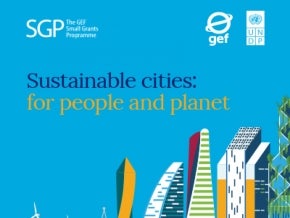
By Chris Luebkeman, Arup fellow and director; Jonelle Simunich, senior strategist, global foresight, research and innovation, Arup
We live on a spaceship. So suggested Buckminster Fuller in his 1968 book, Operating Manual for Spaceship Earth. It depicts a self-contained environment with finite resources and no resupply, a closed ecosystem wherein all production, consumption, waste, and materials must originate and remain. If we are successfully to function, and thrive, we must remember that Earth is humanity’s sole environment. And like any vessel, we must pay attention to its maintenance.
We have entered the Anthropocene, where human activity is responsible for the dominant impact on the global commons of the Earth’s natural systems. It strains our natural resources, damages ecologies and promotes unequal distribution and consumption of materials driven by local needs and desires.
We are already feeling the effects of delayed planet maintenance. In 2007, Nasa climate scientists told us that the safe upper limit for carbon dioxide – so human life is not jeopardised – is 350 parts per million (ppm), yet the Earth has just passed 400 ppm. Breaching this threshold manifests across the world as severe weather events, sea level rise, ocean acidification, massive temperature anomalies, methane releases and widespread drought. These changes have disastrous implications for natural ecosystems, wildlife, agricultural production, water resources, cities – and human existence.
We are the first generation to have enough data to understand and articulate what has been happening to our planet as a result of our collective behaviour. The Stockholm Resilience Centre has identified nine planetary boundaries which regulate the Earth’s stability and resilience. Each has, or will have, a science-based target within which human activity must remain. Science is working to define these safe limits, providing a fantastic opportunity – and responsibility – to take action.
Cities are our collective blessing and curse – economic powerhouses, catalysts for change, and providers of prosperity. They are hubs of innovation full of limitless possibilities. They can also be profoundly wasteful, are major consumers of resources, produce massive amounts of trash, devour immense quantities of food, and have escalated pollution to scales never imagined, putting enormous strain on Earth’s ecological and biological systems.
Today, 54% of the global population lives in cities. By 2050 the proportion is projected to be over 66%. We must increase the emphasis on lowering carbon emissions, minimising waste, reducing reliance on fossil fuels and restoring vulnerable supply chains. We have identified 16 urban systems that relate to all cities regardless of size, economy or location. It is a complex system of systems, where everything is connected with and impacted by everything else. Understanding these impacts will help us begin to identify possible, probable and scalable solutions.
Urban systems
- Mobility
- Commerce
- Education
- Housing
- Safety
- Security
- Sports
- Entertainment
- Energy
- Water
- Nourishment (food)
- Governance
- Nature
- Waste
- Wellness
- Production
Towards restorative cities
The UN estimates that over “60% of the land projected to be urban in 2030 is yet to be built.” Now is the time for creators, thought leaders and innovators of the built environment to design and retrofit cities to develop a sustainable and habitable Earth for generations to come.
Our short but steep learning curve has led us to explore and incorporate renewable sources of energy into buildings; to value ecological networks; to integrate street trees and vegetative facades; and to use data-driven design to minimise the ecological footprint of structures. These urban remedies are moving in the right direction, but we need more of them and faster. We need a step change in the design and construction of the built environment to restore Earth’s natural resources and build a better future. We must determine how to create restorative cities at varying scales and in every bioclimatic zone. We need science based targets for cities to achieve this and guide the development of new norms, exemplars and best.
If we are to achieve restorative and thriving cities we must fundamentally re-think how we design, develop, and inhabit our urban environments.
Cities are hubs of opportunity. This is what drives us to reside and gather within them. Enacting meaningful change will be a long and winding road. It will require each and every one of us to be engaged participants – awake, aware, and active – on the journey. Envisioning, developing and delivering our ideal future with restorative cities, communities, neighborhoods and structures will be a massive, yet critical, undertaking. We must be intentional in both large and small changes to our daily life, today and tomorrow.
Restorative urban systems will be key to whether all species on our planet thrive. It is in our best interest that we pay attention to this now. We must protect this small blue marble as we hurl through the infinite blackness of space. It is our one, and only, spaceship Earth.


